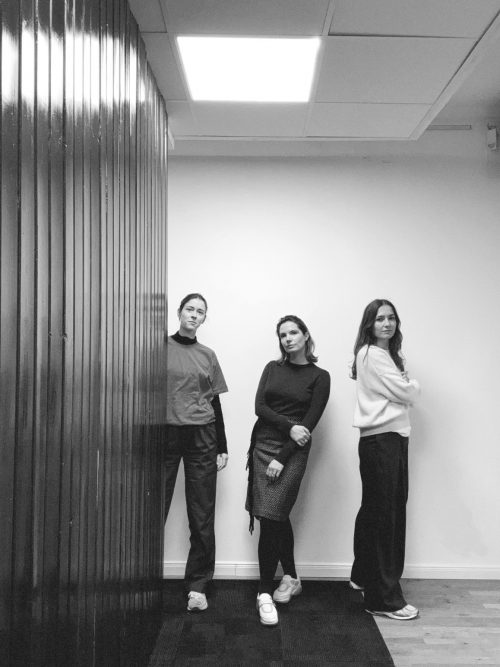
Juan Larraín Gonzaléz
Tereso y Margarito
Project Info
- 💙 Sangt Hipolyt
- 💚 Anne Fellner
- 🖤 Juan Larraín Gonzaléz
- 💜 Cosima zu Knyphausen
- 💛 exhibitiondocumentation
Share on

Exhibition View
Advertisement

Exhibition View

Exhibition View

Exhibition View

Exhibition View

Exhibition View

Exhibition View

Exhibition View

Untitled, 2023, oil on canvas, 100 x 130 cm

Cuncuna, 2022, oil on linen, 65 x 50 cm

Untitled, 2023, oil on wood board, 45 x 60 cm

A new rule book (Night), 2023, oil on canvas, 65 x 85 cm

Indoor Lighting, 2022, cold wax and oil on linen, 65 x 85 cm

Colillas, 2022, cold wax and oil on board, 15 x 20 cm

Cruz de navajas, 2023, oil on board, 40 x 30 cm

Untitled, 2022, oil on linen, 100 x 130 cm

An ancient fear (Morning), 2023, oil on canvas, 65 x 85 cm
–Tereso, qué lindo, ¿nocierto?– decía, con la vista perdida
en un recuerdo que sólo él disfrutaba. 1
– Tereso, how pretty, right? – he said, with his eyes
lost in a memory that only he enjoyed.
An endemic memory of central Chile, on a spring day, is the inescapable collision with the pololos; hairy, orange-colored bugs with three black stripes. They are abundant, their flight is slow and inscrutably clumsy, and they always stick to clothing.
The name comes from the Mapudungun word pëlulu, which means to flutter like a fly. Thus, pololo also means “boyfriend.”
In a classroom full of girls, hearing a classmate tearing the already fragile attention away from something else with the adolescent lament “I need a pololo!” was a daily occurrence. I also harboured the hope of a certain fluttering around my precious flowers, which although at the same time seemed mediocre to me (as they were mine), were full of the desire to pollinate something in this world.
There was only one problem... my complex was to be something like a stick grasshopper. Whoever didn't notice it at first, would notice it at second glance: my presence, a ‘prosicopiidatic’ imposture of femininity, stood out uncomfortably among that of my peers, which seemed to emanate effortlessly and with pure natural grace.
–Hueona you are not an insect–, was one of Juan's first manifestations of love in our friendship, which opened a beautiful path of reinterpreting our stories together.
Nature metaphors, when not monopolized by pseudoscience to discredit queer experience, can be something like Virginia Woolf thinking about Vita:
I feel like a moth, with heavy scarlet eyes and a soft cape of down -- a moth about to settle in a sweet bush -- Would it were -- ah but that's improper. 2
Perhaps the characteristic of queer beauty lies in its mutable capacity to integrate disgust, the sublimation of rejection and fear of the unknown into the encounter with daily life.
A butterfly must be hideous in the eyes of conservative caterpillars. “Not with our larvae,” they say, and waste all their skills in the attempt to preserve a fixed form of themselves. But they don’t know what happens inside a cocoon is a complete dissolution; after entering into a liquid state (!) the caterpillar soup (which must be something like pure feeling or pure memory) can rearticulate itself again.
Within our anthropomorphic frameworks, painting can offer a modest approach to this principle.
The motifs of Juan's paintings allude to elements that surrounded them in their childhood in the Chilean countryside, as well as the ubiquity of certain bugs here, with their narrative and symbolic potential, to find out what they can say about non-binary experience, loneliness, a sense of belonging and the yearning to be loved.
I heard a Fly buzz –when I died–, begins a poem by Emily Dickinson.
And Juan, sitting one day in the cemetery of Südstern, thinking about all the great issues of this life, got distracted by a brutal feast of ants.
I find that, although they might differ in their sexual practices, firebugs look a bit like pololos. Perhaps there are, among them, some Teresos and Margaritos who came to Berlin; to meet, to set themselves on fire, to get lost in a multitude and to do things that are vernacular and universal at the same time.
Cosima zu Knyphausen
1 Pedro Lemebel in: Contardo, Óscar, “Loca fuerte, Retrato de Pedro Lemebel” (2022). Ediciones Universidad Diego Portales, Santiago (2022). p. 40
2 Cramer, Patricia Morgne, "Virginia Woolf: Liberating Lesbian Readings from Heterosexual Bias" (2010). English - Stamford: Articles, Papers and Presentations. p. 4
Cosima zu Knyphausen




